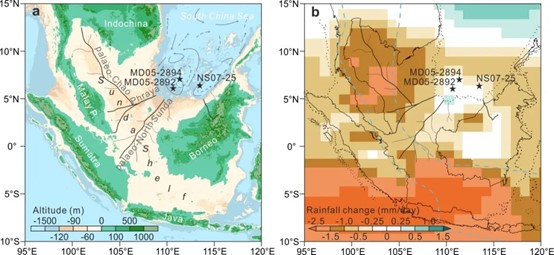Zhongjing Cheng a,* , Jiawang Wu b , Chuanxiu Luo c , Zhifei Liu a , Enqing Huang a , Hongchao Zhao a , Lu Dai a , Chengyu Weng a
a State Key Laboratory of Marine Geology, Tongji University, Shanghai 200092, China
b School of Marine Sciences, Sun Yat-Sen University, Zhuhai 519082, China
c Key Laboratory of Ocean and Marginal Sea Geology, South China Sea Institute of Oceanology, Chinese Academy of Sciences, Guangzhou 510301, China
*Corresponding author.
E-mail address: magnolia_czj@tongji.edu.cn (Z. Cheng).
Abstract
The capability of tropical forest to recover from extensive land-use remains a matter of debate, despite its importance for guiding conservation and restoration policies. This is especially the case for Southeast Asia. Fortunately, the Sunda Shelf was extensively exposed during the Last Glacial Maximum sea-level lowstand, providing a unique window to study the long-term and landscape-scale development of tropical forest in new accommodation spaces that may be analogous to those emerge after the cessation of human activities. Here we conduct pollen analyses on three sediment cores from the southern South China Sea – two located in front of the Sunda Shelf paleo-river mouths and one close to the northern Borneo – in order to evaluate the similarity/difference between the “primary” and “secondary” tropical forest of Southeast Asia. The assemblages of major pollen taxa and the life-form composition of identified plant types are found to be quite similar among the sites, indicating that well-structured rainforest should have expanded to the Sunda Shelf despite the sandy and potentially saline, nutrient-poor soils. The plant biodiversity, however, was obviously lower on the Sunda Shelf than on Borneo as inferred from the pollen richness. This indicates a loss of biodiversity during large-scale range expansions. Our findings suggest the potential of reforestation in the lowlands of Southeast Asia, but unfortunately the incapability of restoring biodiversity to pre-disturbance levels through natural regeneration alone. Moreover, the old forests in the mountainous northern Borneo appears to be irreplaceable and thus a priority of conservation efforts.
Full article:https://doi.org/10.1016/j.gloplacha.2024.104597

Fig. Maps of the Sundaland. (a) Marine sediment cores on the topographic map, with modern surface currents and LGM palaeo-river systems. (b) Model simulated rainfall changes between the LGM and pre-industry show similar climates in the palaeo-North Sunda River catchment and northern Borneo.

